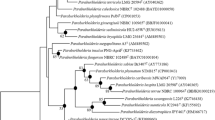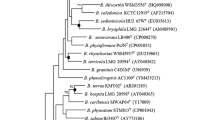Abstract
A new bacterium, designated DCY113T, was isolated from ginseng cultivation soil in Gochang-gun, South Korea, and its taxonomic position identified by the polyphasic approach. 16S rRNA gene sequence analysis determined that this isolate belongs to the genus Paraburkholderia, and was closest to P. dipogonis DL7T (98.6%), P. phytofirmans PsJNT (98.5%), P. kirstenboschensis Kb15T (98.4%) and P. aromaticivorans BNT (98.1%). Strain DCY113T is Gram-reaction negative, strictly aerobic, rod-shaped, non-motile, and catalase and oxidase positive. The predominant isoprenoid quinone of DCY113T was ubiquinone Q-8. The major cellular fatty acids were C16:0, cyclo-C17:0 and the Summed feature 8 (C18:1ω7c and/or C18:1ω6c). The major polar lipids were diphosphatidylglycerol (DPG), phosphatidylglycerol (PG), phosphatidylethanolamine (PE), and an unknown amino lipid (AL1). The G+C content of the genomic DNA was 62.2 mol%. Average nucleotide identity (ANI) between strain DCY113T and the related Paraburkholderia type strains were below the threshold value for species delineation. This low DNA relatedness in combination with phylogenetic and phenotypic tests indicates that strain DCY113T cannot be assigned to any recognized species. Strain DCY113T was also found to have antifungal activity against the pathogenic fungi Cylindrocarpon destructans. In conclusion, this study found DCY113T to be a novel species within the genus Paraburkholderia, for which the name P. panacisoli is proposed. The type strain is DCY113T (= KCTC 52951T = JCM 32098T).

Similar content being viewed by others
References
Bauer A, Kirby W, Sherris JC, Turck M (1966) Antibiotic susceptibility testing by a standardized single disk method. Am J Clin Pathol 45:493–496
Bernardet JF, Nakagawa Y, Holmes B (2002) Proposed minimal standards for describing new taxa of the family Flavobacteriaceae and emended description of the family. Int J Syst Evol Microbiol 52:1049–1070
Bournaud C, Moulin L, Cnockaert M, de Faria S, Prin Y, Severac D, Vandamme P (2017) Paraburkholderia piptadeniae sp. nov. and Paraburkholderia ribeironis sp. nov., two root-nodulating symbiotic species of Piptadenia gonoacantha in Brazil. Int J Syst Evol Microbiol 67:432–440
Choi GM, Im WT (2017) Paraburkholderia azotifigens sp. nov., a nitrogen-fixing bacterium isolated from paddy soil. Int J Syst Evol Microbiol 68:310–316
Farh ME-A, Kim YJ, Van An H, Sukweenadhi J, Singh P, Huq MA, Yang DC (2015) Burkholderia ginsengiterrae sp. nov. and Burkholderia panaciterrae sp. nov., antagonistic bacteria against root rot pathogen Cylindrocarpon destructans, isolated from ginseng soil. Arch Microbiol 197:439–447
Felsenstein J (1981) Evolutionary trees from DNA sequences: a maximum likelihood approach. J Mol Evol 17:368–376
Felsenstein J (1985) Confidence limits on phylogenies: an approach using the bootstrap. Evolution 39:783–791
Gao ZQ, Zhao DY, Xu L, Zhao RT, Chen M, Zhang CZ (2016) Paraburkholderia caffeinitolerans sp. nov., a caffeine degrading species isolated from a tea plantation soil sample. Anto Van Leeu 109:1475–1482
Hall TA (1999) BioEdit: a user-friendly biological sequence alignment editor and analysis program for Windows 95/98/NT. Nucleic Acids Symp Ser 41:95–98
Han JH, Park GC, Kim KS (2017) Antagonistic Evaluation of Chromobacterium sp. JH7 for biological control of ginseng root rot caused by Cylindrocarpon destructans. Mycobiology 45:370–378
Hiraishi A, Ueda Y, Ishihara J, Mori T (1996) Comparative lipoquinone analysis of influent sewage and activated sludge by high-performance liquid chromatography and photodiode array detection. J Gen Appl Microbiol 42:457–469
Johnson M, Zaretskaya I, Raytselis Y, Merezhuk Y, McGinnis S, Madden TL (2008) NCBI BLAST: a better web interface. Nucleic Acids Res 36:W5–W9
Kang JP, Nguyen NL, Kim YJ, Hoang VA, Bae KS, Yang DC (2015) Paralcaligenes ginsengisoli sp. nov., isolated from ginseng cultivated soil. Anto Van Lee 108:619–626
Kim OS et al (2012) Introducing EzTaxon-e: a prokaryotic 16S rRNA gene sequence database with phylotypes that represent uncultured species. Int J Syst Evol Microbiol 62:716–721
Lane D (1991) 16S/23S rRNA sequencing. In: Stackebrandt E, Goodfellow M (eds) Nucleic acid techniques in bacterial systematics. Wiley, Chichester, UK, pp 115–175
Lee YH, Jeon CO (2018) Paraburkholderia aromaticivorans sp. nov., an aromatic hydrocarbon-degrading bacterium, isolated from gasoline-contaminated soil. Int J Syst Evol Microbiol 68:1251–1257
Levine M, Epstein S, Vaughn R (1934) Differential reactions in the colon group of bacteria. Am J Public Health Nations Health 24:505–510
Li Y, Ying Y, Ding W (2014) Dynamics of Panax ginseng Rhizospheric soil microbial community and their metabolic function. Evid Based Complement Alternat Med. https://doi.org/10.1155/2014/160373
Lv YY, Chen MH, Xia F, Wang J, Qiu LH (2016) Paraburkholderia pallidirosea sp. nov., isolated from a monsoon evergreen broad-leaved forest soil. Int J Syst Evol Microbiol 66:4537–4542
Mesbah M, Premachandran U, Whitman WB (1989) Precise measurement of the G+ C content of deoxyribonucleic acid by high-performance liquid chromatography. Int J Syst Evol Microbiol 39:159–167
Minnikin D, O’donnell A, Goodfellow M, Alderson G, Athalye M, Schaal A, Parlett J (1984) An integrated procedure for the extraction of bacterial isoprenoid quinones and polar lipids. J Microbiol Methods 2:233–241
Rahman M, Punja ZK (2005) Factors influencing development of root rot on ginseng caused by Cylindrocarpon destructans. Phytopathology 95:1381–1390
Richter M, Rosselló-Móra R (2009) Shifting the genomic gold standard for the prokaryotic species definition. Proc Natl Acad Sci USA 106:19126–19131
Saitou N, Nei M (1987) The neighbor-joining method: a new method for reconstructing phylogenetic trees. Mol Biol Evol 4:406–425
Sasser M (1990) Identification of bacteria by gas chromatography of cellular fatty acids. MIDI Technical Note 101. MIDI Inc, Newark, DE
Sawana A, Adeolu M, Gupta RS (2014) Molecular signatures and phylogenomic analysis of the genus Burkholderia: proposal for division of this genus into the emended genus Burkholderia containing pathogenic organisms and a new genus Paraburkholderia gen. nov. harboring environmental species. Front Genet 5:429
Sessitsch A et al (2005) Burkholderia phytofirmans sp. nov., a novel plant-associated bacterium with plant-beneficial properties. Int J Syst Evol Microbiol 55:1187–1192
Sheu SY et al (2015) Burkholderia dipogonis sp. nov., isolated from root nodules of Dipogon lignosus in New Zealand and Western Australia. Int J Syst Evol Microbiol 65:4716–4723
Steenkamp ET, van Zyl E, Beukes CW, Avontuur JR, Chan WY, Palmer M, Mthombeni LS, KaraboSereme T, Stephanus NV (2015) Burkholderia kirstenboschensis sp. nov. nodulates papilionoid legumes indigenous to South Africa. Syst Appl Microbiol 38:545–554
Tamura K, Nei M (1993) Estimation of the number of nucleotide substitutions in the control region of mitochondrial DNA in humans and chimpanzees. Mol Biol Evol 10:512–526
Tamura K, Stecher G, Peterson D, Filipski A, Kumar S (2013) MEGA6: molecular evolutionary genetics analysis version 6.0. Mol Biol Evol 30:2725–2729
Thompson JD, Gibson TJ, Plewniak F, Jeanmougin F, Higgins DG (1997) The CLUSTAL_X windows interface: flexible strategies for multiple sequence alignment aided by quality analysis tools. Nucleic Acids Res 25:4876–4882
Wayne LG et al (1987) International Committee on Systematic Bacteriology. Report of the ad hoc committee on reconciliation of approaches to bacterial systematics. Int J Syst Bacteriol 37:463–464
Weber CF, King GM (2017) Volcanic soils as sources of novel CO-Oxidizing Paraburkholderia and Burkholderia: Paraburkholderia hiiakae sp. nov., Paraburkholderia metrosideri sp. nov., Paraburkholderia paradisi sp. nov., Paraburkholderia peleae sp. nov., and Burkholderia alpina sp. nov. a member of the Burkholderia cepacia complex. Front Microbiol 8:207
Acknowledgements
This work was supported by the (2011) Grant from the Korean Society of Ginseng.
Author information
Authors and Affiliations
Corresponding authors
Ethics declarations
Conflict of interest
The authors declare that there are no conflicts of interest.
Additional information
Communicated by Erko Stackebrandt.
Publisher's Note
Springer Nature remains neutral with regard to jurisdictional claims in published maps and institutional affiliations.
The NCBI GenBank accession numbers for the 16S rRNA gene sequence and the draft genome of strain DCY113T are KY694398 and VTUZ00000000, respectively.
Electronic supplementary material
Below is the link to the electronic supplementary material.
Rights and permissions
About this article
Cite this article
Huo, Y., Chokkalingam, M., Kang, JP. et al. Paraburkholderia panacisoli sp. nov., a potentially antagonistic bacterium against the root rot fungal pathogen Cylindrocarpon destructans, isolated from ginseng cultivation soil. Arch Microbiol 202, 1341–1347 (2020). https://doi.org/10.1007/s00203-020-01840-z
Received:
Revised:
Accepted:
Published:
Issue Date:
DOI: https://doi.org/10.1007/s00203-020-01840-z




